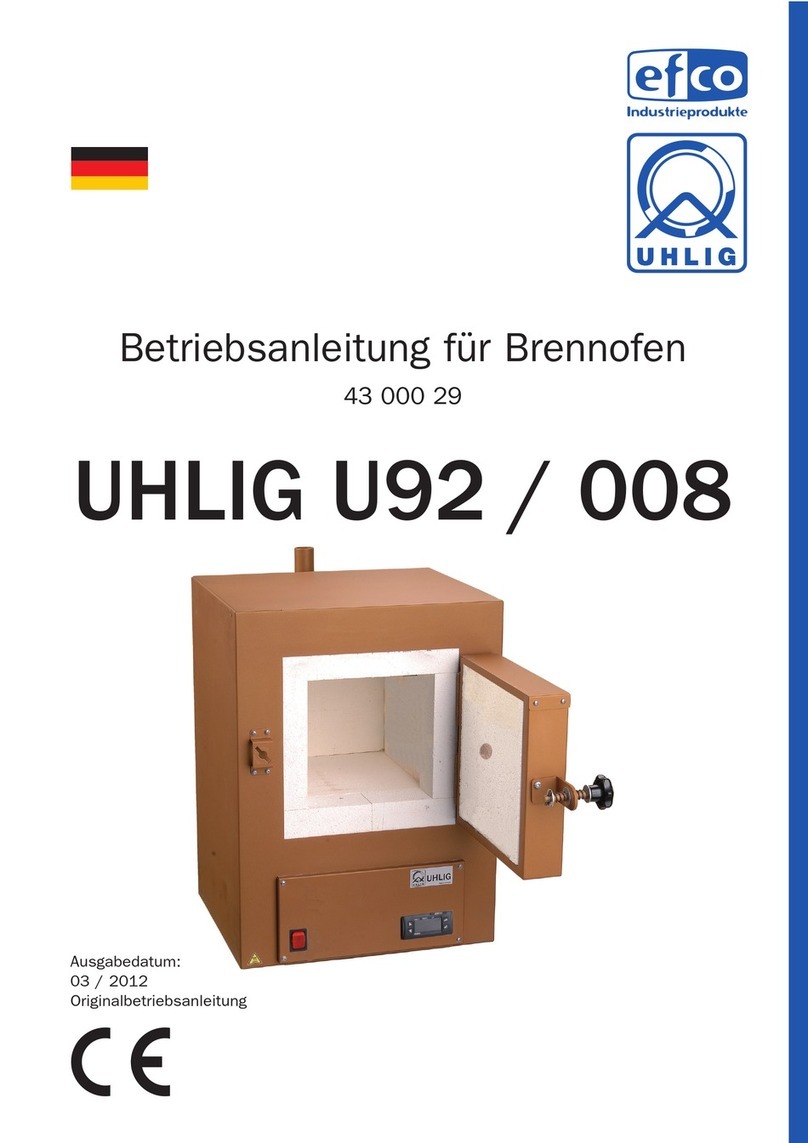13.Erweiterte Sicherheitshinweise:
1. Gefahrloses Arbeiten mit Ihrem Ofen ist nur möglich, wenn Sie die Bedienungsanleitung und die Sicherheitshinweise vollständig lesen und
die darin enthaltenen Hinweise strikt befolgen.
2. Informieren Sie ausführlich vor der Anwendung Ihres Ofens die beteiligten Personen über diese Sicherheitshinweise.
3. Bewahren Sie die Sicherheitshinweise gut auf, bzw. halten Sie diese bei Gebrauch stets bereit.
4. Fehler bei der Einhaltung der nachfolgend aufgeführten Hinweise können elektrischen Schlag, Brand und/oder schwere Verletzungen verursachen.
5. Dieser Ofen ist ausschließlich nur für den beschriebenen und angegebenen Verwendungszweck geeignet und von Ihnen zu benutzen.
6. Halten Sie Ihren Arbeitsplatz sauber und aufgeräumt.
7. Der Ofen darf nur auf einer feuerfesten Unterlage betrieben werden.
8. Während der Arbeit können gesundheits- beeinträchtigende Dämpfe entstehen. Sorgen Sie für eine gute Belüftung oder einen geeigneten
Abzug.
9. Arbeiten Sie mit Ihrem Ofen nicht in explosionsgefährdeter Umgebung, in der sich brennbare Flüssigkeiten, Gase oder Stäube befinden.
10. Ihr Ofen darf nicht feucht sein oder in feuchter Umgebung betrieben werden.
11. Benutzen Sie zur Beschickung und zur Entnahme geeignetes Werkzeug und tragen Sie Wärmeschutzhandschuhe und eine Schutzbrille.
12. Brenngut, das Sie dem Ofen entnehmen kann sehr heiß sein. Legen Sie das Brenngut auf einer feuerfesten Unterlage zum abkühlen ab.
13. Ofen trocken und frostsicher aufbewahren.
14. Benutzen Sie Ihren Ofen nur in gut belüfteten Räumen.
15. Schließen Sie den Ofen, wenn nicht anders angegeben, nur an Wechselspannung (U~) an und prüfen Sie, ob Ihre Netzspannung mit der
Spannungsangabe auf dem Ofen übereinstimmt.
16. Vermeiden Sie starke mechanische Beanspruchung und stellen Sie den Ofen nicht auf einen instabilen Untergrund.
17. Durch Herabfallen können Personen verletzt und Gegenstände entzündet werden.
18. Ziehen Sie immer den Netzstecker aus der Steckdose, wenn der Ofen nicht in Gebrauch ist.
19. Wickeln Sie das Netzkabel nicht um den Ofen.
20. Überprüfen Sie das Netzkabel und Ihren Ofen vor Gebrauch auf Schadstellen.
21. Ein defekter Ofen muss sofort vom Netz getrennt werden und gegen unbeabsichtigte Weiterbenutzung gesichert werden.
22. Seien Sie aufmerksam, achten Sie darauf, was Sie tun und gehen Sie mit Vernunft an die Arbeit mit Ihrem Ofen.
23. Benutzen Sie den Ofen nicht, wenn Sie müde sind oder unter Einfluss von Drogen, Alkohol oder Medikamenten stehen.
24. Dieser Ofen ist nicht dafür bestimmt durch Personen (einschließlich Kinder) mit eingeschränkten physikalischen, sensorischen oder gei-
stigen Fähigkeiten oder mangels Erfahrung und/oder Wissen benutzt zu werden, es sei denn sie werden durch eine für Ihre Sicherheit
zuständige Person beaufsichtigt oder erhielten von ihr Anweisungen wie der Ofen zu benutzen ist.
25. Grundsätzlich raten wir aber, den Ofen von Kindern fern zu halten.
26. Lassen Sie Verpackungsmaterial nicht achtlos liegen.
27. Plastikfolien/-tüten, Styroporteile etc. können für Kinder zu einer Gefährdung werden.
28. Bedingt durch die gewollte Funktion Ihres Ofens entsteht Hitze.
29. Schützen Sie Augen, Hände und Körper durch geeignete Arbeitsschutzkleidung.
30. Tragen Sie keinen Schmuck und keine hitzeempfindliche oder weite Kleidung.
31. Eine Berührung der Tür oder des Brennraumes kann zu schweren Verbrennungen führen.
32. Sorgen Sie für einen sicheren Stand und halten Sie jederzeit Ihr Gleichgewicht.
33. Vermeiden Sie eine unbeabsichtigte Inbetriebnahme.
34. Vergewissern Sie sich, dass der Schalter (wenn vorhanden) in der Position „Aus“, „OFF“ oder „0“ steht, bevor Sie den Stecker in die
Steckdose stecken.
35. Gerät wird speziell an der Tür und im Brennraum heiß.
36. Halten Sie immer ausreichend Abstand zu den heißen Teilen.
37. Lassen Sie nach jeder Benutzung - und speziell vor dem Einpacken nach Beendigung Ihrer Arbeiten – Ihren Ofen ausreichend lange abkühlen.
38. Dieses Gerät ist nicht geeignet:
- Zum Erwärmen und Trocknen von Haaren, Körperteilen, Fingernägeln, Tieren
- Zum Aufheizen und Schmelzen von Flüssigkeiten,
39. Benutzung Sie aus Sicherheitsgründen diesen Ofen nur unter ständiger Aufsicht von Erwachsenen und erfahrenen Personen.
40. Bewahren Sie Ihren Ofen außerhalb der Reichweite von Kindern auf.
41. Gestatten Sie niemals Kindern die Benutzung dieses Ofens.
42. Lassen Sie Personen, die mit diesem Ofen nicht vertraut sind oder diese Anweisung nicht gelesen haben, diesen Ofen nicht benutzen.
43. Pflegen Sie diesen Ofen mit Sorgfalt.
44. Der Ofen darf nicht verändert, demontiert oder mechanisch geöffnet werden.
45. Lassen Sie den Ofen nicht mit flüssigen Stoffen (Wasser, Reinigungsmittel usw.) in Berührung kommen.
46. Entsorgungshinweis - Rückstoffgewinnung statt Müllentsorgung –
47. Dieser Ofen darf am Ende seiner Lebensdauer nicht mit dem Hausmüll entsorgt werden.
48. Elektronische Geräte sind entsprechend der Richtlinie über Elektro- und Elektronik-Altgeräte über die örtlichen Sammelstellen für
Elektronik-Altgeräte zu entsorgen!
49. Für direkte oder indirekte Schäden, die durch unsachgemäße Handhabung entstanden sind, können wir keine Haftung übernehmen.
50. Optische und technische Änderungen vorbehalten.
Hobbygross Erler GmbH
Große Ahlmühle 10
76865 Rohrbach
Germany





























